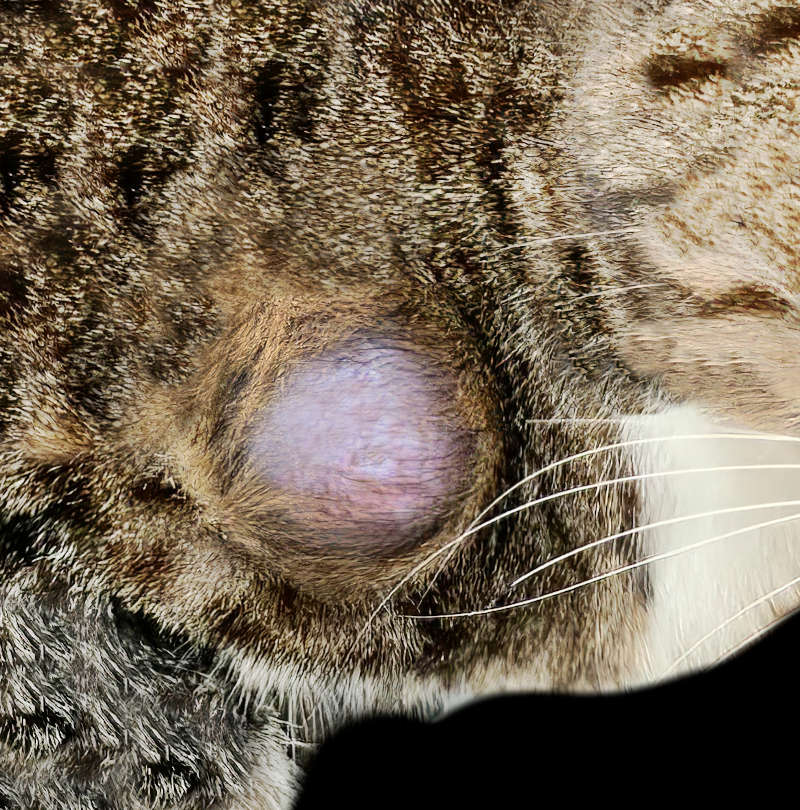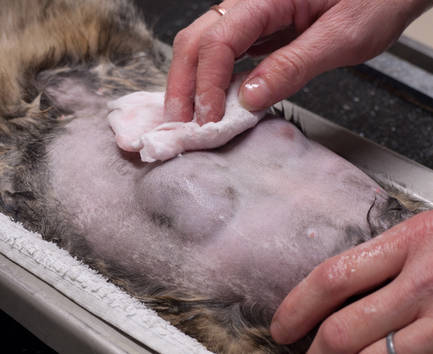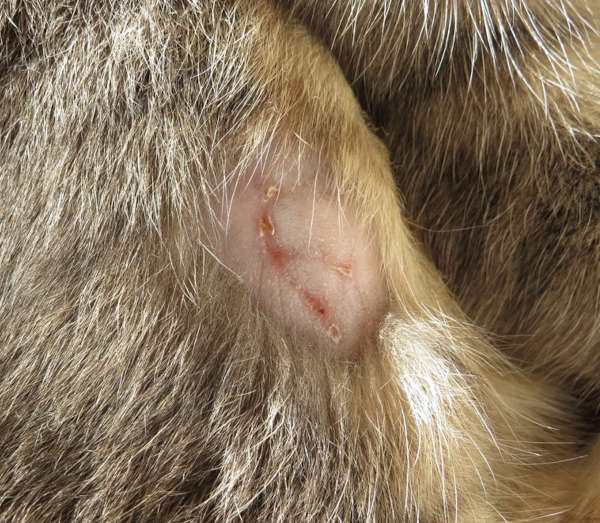You’re playing with your cat or giving them some late-night cuddles and you notice something on their belly that doesn’t feel quite right…
Lumps on a cat’s belly often come as a surprise, as many of our feline friends are highly offended if you try to have a feel down there. It can be hard to know how long it’s been there, or what to do next. Unfortunately, some of the lumps we diagnose in this area can be quite unpleasant – but they aren’t always bad news. In this article we’ll look at some of the types of lumps we see on cats’ bellies and how to tell the difference between them.
Lumps on the belly vs in the belly
This article focuses on lumps on the belly, as these are the main types of lump we see owners bring their cats in for – however, we’ll also give a brief overview of what you might be dealing with if you feel a lump in your cat’s belly.
The majority of lumps that develop within a cat’s abdomen aren’t felt by owners at home – it usually takes more thorough palpation of the abdomen by your vet to detect them. Often, we see these cats come in due to problems like weight loss, vomiting, lethargy or struggling to toilet.
What are common types of lumps or bumps on a cat’s stomach or belly?
Lumps on the belly are much more likely to be noticed at home. Some of the most common types of lumps are discussed below:
-
Lipomas
Lipomas are a relatively common type of lump in cats (although less common than in dogs). They are are a benign (non-cancerous) type of tumor originating from fat cells. These lumps are typically seen in older cats as slow growing, non-painful, freely moveable lumps under the skin, which usually feel smooth and well demarcated.

As benign lumps, these usually don’t need treatment unless they start to get in the way, in which case surgery is usually curative. It’s important to get any new lumps checked, however, to make sure it’s not a different type of lump that requires treatment.
-
Mammary masses
Mammary tumors


Mammary tumors are the third most common type of tumor in cats, responsible for approximately 20% of tumors in female cats. These tumors are typically seen in middle-aged to older cats, although occasionally young cats can be affected, and affect all breeds, although Siamese cats in particular have a two-fold increase in risk. Intact (unspayed / entire) female cats are at approximately 7x higher risk than spayed females, although females spayed later and, rarely, males can be affected.
The mammary glands are present in two chains extending along the abdomen and chest. Tumors can develop in any of these glands and frequently develop in multiple glands at the same time. You may therefore notice a single mass or multiple masses across your cat’s belly. Most (but not all) masses will be a firm, well defined mass, although they may have an irregular shape. They often adhere to the overlying skin and, if malignant, may cause ulceration or irritation.
Sadly, 80% of mammary masses in cats are malignant (cancerous) and they are often highly aggressive, infiltrating into the surrounding area and spreading to other organs including the lungs. Diagnosis is usually based on clinical examination and history; fine needle aspirates are usually not useful. Treatment requires surgical removal of the mammary glands. The mammary glands in cats are often linked, so a thorough approach involves staged removal of both chains of mammary glands, leaving 3-4 weeks between surgery on each side. Your vet will usually also recommend chest x-rays prior to surgery and potentially other investigations to rule out spread to these areas. In some cases, chemotherapy may be useful. For a definitive diagnosis and to check whether the whole tumor has been removed, histopathology (examination under a microscope) is often performed after surgery.
The prognosis depends on the size of the tumor, whether it has spread and other clinical factors. For tumors less than 2cm diameter, cats are likely to survive over 3 years with surgery. If the tumor is larger than 3cm, survival is unfortunately likely to be under 12 months even with surgery. Learn more about mammary tumors.
Mammary fibroadenomatous hyperplasia (overgrowth of mammary glands)
We occasionally see rapid development of enlarged mammary glands. The enlarged glands can be firm and irregular and the overlying skin may appear inflamed or even begin to die and slough off. This can be very alarming – it appears similar to some very aggressive tumors. It is, however, a benign (non-cancerous) condition that occurs due to hormonal stimulation, often appearing 1-2 weeks after a queen’s first oestrus (heat).
This condition usually resolves spontaneously over several weeks, but can recur in subsequent cycles. Your vet may recommend spaying your cat, as this is often curative (although it can still take time to resolve). Depending on how severe your cat’s case is, they may also recommend pain relief, a buster collar or pet shirt to prevent your cat licking and causing trauma. Occasionally, if the skin has been traumatised, secondary infection may also be present and require treatment.
If you notice any lump under your cat’s belly, we recommend getting it checked by your vet as soon as possible. Although these can occasionally be due to a benign condition, malignant tumors are common and need early treatment for the best possible prognosis.
-
Abscesses
Cats of all ages, especially those that go outdoors or live in multi-cat households, frequently develop abscesses if they are wounded. These are often around the head and neck area but may occasionally be seen on the belly. These usually appear fairly rapidly, as painful swellings, sometimes with discharge. Your cat may also be lethargic or inappetent and try to avoid the area being touched.

These can usually be recognized easily on clinical examination by your vet, although occasionally a fine needle aspirate is needed which can show pus within the mass. Treatment usually involves antibiotics and pain relief, preventing your cat from licking the area and, in some cases, lancing and flushing out the contents of the abscess (potentially under sedation). The prognosis for abscesses is generally very good, although this depends on the severity of the abscess.
-
Skin lumps
There are many different types of skin tumor that can affect cats, including mast cell tumors, squamous cell carcinoma, basal cell tumors and adenocarcinomas. In addition to tumors, other lumps like cysts can occasionally be seen. We see very few skin related lumps in cats compared to dogs and benign skin lumps are much less common. There is a much higher chance that a skin lump in a cat may be cancerous, so any new or changing lump should be checked.
Mast cell tumors are the most common type of skin tumor in cats. They can occur anywhere in the skin and are most commonly benign, although they can be malignant. They usually occur as firm, hairless nodules, often pale in colour, and approximately 25% of cases have multiple masses at presentation. These masses can usually be diagnosed by fine needle aspirate. Depending on the case, your vet may also recommend further investigations like abdominal ultrasound to check for tumors internally.
Treatment is usually surgical, and can have a very good prognosis although this depends on whether metastasis (spread to other organs) has occurred and how aggressive the tumor is.
-
Soft tissue sarcomas (fibrosarcomas)
Image: Check this image from Today’s Veterinary Practice magazine.
Soft tissue sarcomas are a group of tumors arising from tissues including the skin, connective tissues, nerve and muscle. Fibrosarcomas are the most common type seen in cats, accounting for 15-17% of skin tumors. They are usually seen as solitary masses in or just under the skin of older cats. They are usually firm and slightly irregular in shape and may adhere to surrounding tissues.
These tumors are usually malignant and frequently infiltrate surrounding tissues, so treatment is by wide surgical excision. Diagnosis is often based on clinical examination; a fine needle aspirate can sometimes be helpful but often does not provide a good sample. In some cases your vet may recommend a larger biopsy prior to surgery to confirm the diagnosis, or they may recommend histopathology following the surgery to check that the tumor has been fully removed and provide a more definitive diagnosis and prognosis. Unfortunately, as these tumors are often very aggressive and infiltrative, the recurrence rate in cats has been reported to be as high as 70%.
What lumps are common in the belly?
- Lymphoma (a type of cancer) associated with the stomach or gut
This is more common in older cats although sadly it can occur in younger ones too. They are often losing weight or have gastrointestinal symptoms like vomiting or diarrhoea. In some cases treatment is possible, either through surgery or chemotherapy, especially if the cancer is caught early.
- Foreign bodies / obstructions
Though we typically think of dogs eating things they shouldn’t, cats can also develop gastrointestinal blockages. This can be due to so-called ‘dietary indiscretion’ (e.g. eating hair ties) or in some cases overgrooming causing hairballs to develop. Treatment of obstructions is usually surgical and many cats recover well from this, although this does depend on the severity of the case.
- Constipation / obstipation
This is most often seen in older cats, who can become dehydrated more easily. It can also be seen in cats with megacolon, in which the gut cannot contract properly. Other factors like diet and a sedentary lifestyle may also contribute.
In this condition hard, dry faeces can become relatively easily palpable within your cat’s abdomen – although this may still be hard to detect if you are not familiar with abdominal palpation. The gut may also be sore or inflamed and your cat can become very uncomfortable, so attempting to feel this at home isn’t usually recommended. Treatment depends on many factors including the severity of the issue and any other health issues.
- Urethral obstruction (blocked bladder)
Male cats may become ‘blocked’ by either urinary stones or ‘plugs’ of material. This is most common in young neutered males and is very rare in females. The bladder is palpable as a very large, distended sphere and is usually painful; it’s not recommended to try to palpate this at home. You’re more likely to notice your cat straining in the litter tray, passing only small dribbles or no urine at all and becoming increasingly lethargic and painful. This is an emergency, so if you notice any of these signs you should see your vet urgently for treatment.
Frequently asked questions
Are lumps and bumps on a cat’s belly serious?
Lumps on a cat’s belly can be very serious – for example, mammary tumors are often highly malignant – and early diagnosis and treatment can make all the difference in whether treatment is successful. While not all lumps on a cat’s belly are cancerous, benign lumps are less common than in dogs, so any new or changing lump should be checked by your vet.
How can you tell if a lump is something to be concerned about?
Even small lumps can unfortunately be something to be concerned about – mammary tumors, for example, are much more likely to be successfully treated if they are still small. It’s therefore very difficult to judge at home whether or not a lump is something to be concerned about. Signs like pain, irritated or ulcerated skin and rapid growth are all concerning in any lump, but will often not be noticeable in the early stages of a malignant lump developing.
Are there any other symptoms to look out for?
Above, we described some of the symptoms that might be seen due to lumps within the abdomen, including lethargy, vomiting and diarrhoea and straining to toilet.
Some of these signs may also be seen due to lumps on the skin. Malignant tumors may cause cats to eat less, lose weight and become more lethargic. If they spread to internal organs, they can also cause increased thirst, vomiting, diarrhoea, and even affect your cat’s ability to breathe if they spread to the lungs.
If you notice any change in your cat’s health, we recommend seeing your vet as soon as possible. Many of these symptoms are very non-specific but they can all indicate an underlying health problem, so it’s important to speak to your vet to try to get to the bottom of things.
Can you do anything at home to help treat these lumps?
The lumps discussed here generally require veterinary treatment. There are, however, some things you can do to help at home.
- Prevent your cat from licking
If a lump is causing irritation or pain, your cat will often try to lick it. Unfortunately, this can traumatise the skin and allow infection in, so it’s important to prevent your cat from licking. This usually requires a ‘buster collar’ (plastic cone) but depending on your cat, they may tolerate a medical pet shirt better.
- Bathe the area
If your cat has a lump that is oozing discharge or appears ulcerated, gentle bathing (if tolerated) may help to keep the area clean. We recommend using cooled boiled water with a small amount of salt and bathing the area gently using cotton wool once or twice a day. Gently but thoroughly pat dry after bathing.
- Monitor your cat’s weight
Some conditions will affect your cat’s weight. If you have discussed a lump with your vet and have opted to monitor it, it’s worth keeping an eye on your cat’s weight. If this starts to drop significantly, discuss with your vet whether further investigations might be needed.
When should you seek veterinary care?
Due to the relatively small number of benign lumps that can be seen on cat’s bellies, it’s worth getting any new or changing lump checked by your vet. While some lumps are benign, any malignant lumps have a much better prognosis if diagnosed and treated as soon as possible.
Dobson, J.M. and X., L.B.D. (2011) BSAVA Manual of Canine and Feline Oncology. Quedgeley: British Small Animal Veterinary Association.

